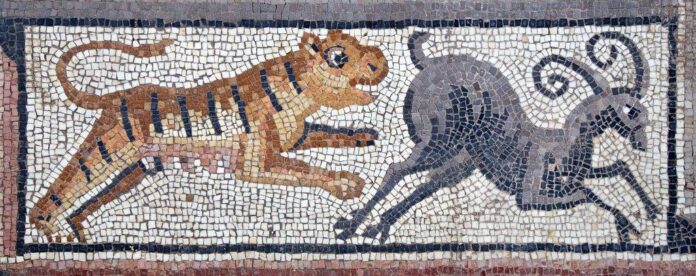A mosaic of a tiger chasing a wild goat dating back to around 400 A.D. has been found in the remains of an ancient Roman synagogue in the Jewish village of Huqoq in Israel’s Lower Galilee.
The researchers who found the panel have described it as “spectacular” and said it is just the latest in a series of “historically significant finds” from an ongoing project at Huqoq.
The dig was led by professor Jodi Magness of the University of North Carolina at Chapel Hill, according to a news release. Other institutions in the Huqoq Excavation Project consortium include Austin College, Baylor University, Brigham Young University, and the University of Toronto.
The panel was found at the south end of the synagogue’s main hall. It features a Hebrew inscription framed within a wreath and an inscription in Aramaic on the sides and below the wreath where there is a list of names believed to either be donors who funded the mosaics or artists who made them.
“The wreath is flanked on either side by lions resting their forepaws on bulls’ heads,” the researchers said in a statement. “The entire panel is surrounded by a decorated border showing animals of prey pursuing other animals.”
The latest dig also uncovered newly exposed sections of previously found mosaics that include a Philistine horseman and a dead Philistine soldier with a strikingly classical face.
The meaning of the tiger chasing the wild goat, also known as an ibex, was not immediately clear, though other mosaics found at the site have been described as portraying stories from Jewish teachings, including two depictions of Samson from the .
Last year, the excavation team returned to the site after a two-year pause caused by the COVID-19 pandemic and discovered “the first known depiction of the biblical heroines Deborah and Jael as described in the .”
Magness previously said that the story might have resonated with the Jewish community at Huqoq at the time because it was “described as taking place in the same geographical region.”
Other stories depicted in art and artifacts found at the site tell stories of Moses and the parting of the Red Sea, the building of the tower of Babel, the swallowing of Jonah, and the building of Noah’s Ark, among others.
The synagogue was ultimately rebuilt about 1,000 years later during the Mamluk Sultanate—a period of Muslim rule in the region.
More Trending Stories:
An Israeli First-Grader Stumbled on a 3,500-Year-Old Egyptian Amulet on a School Trip

























